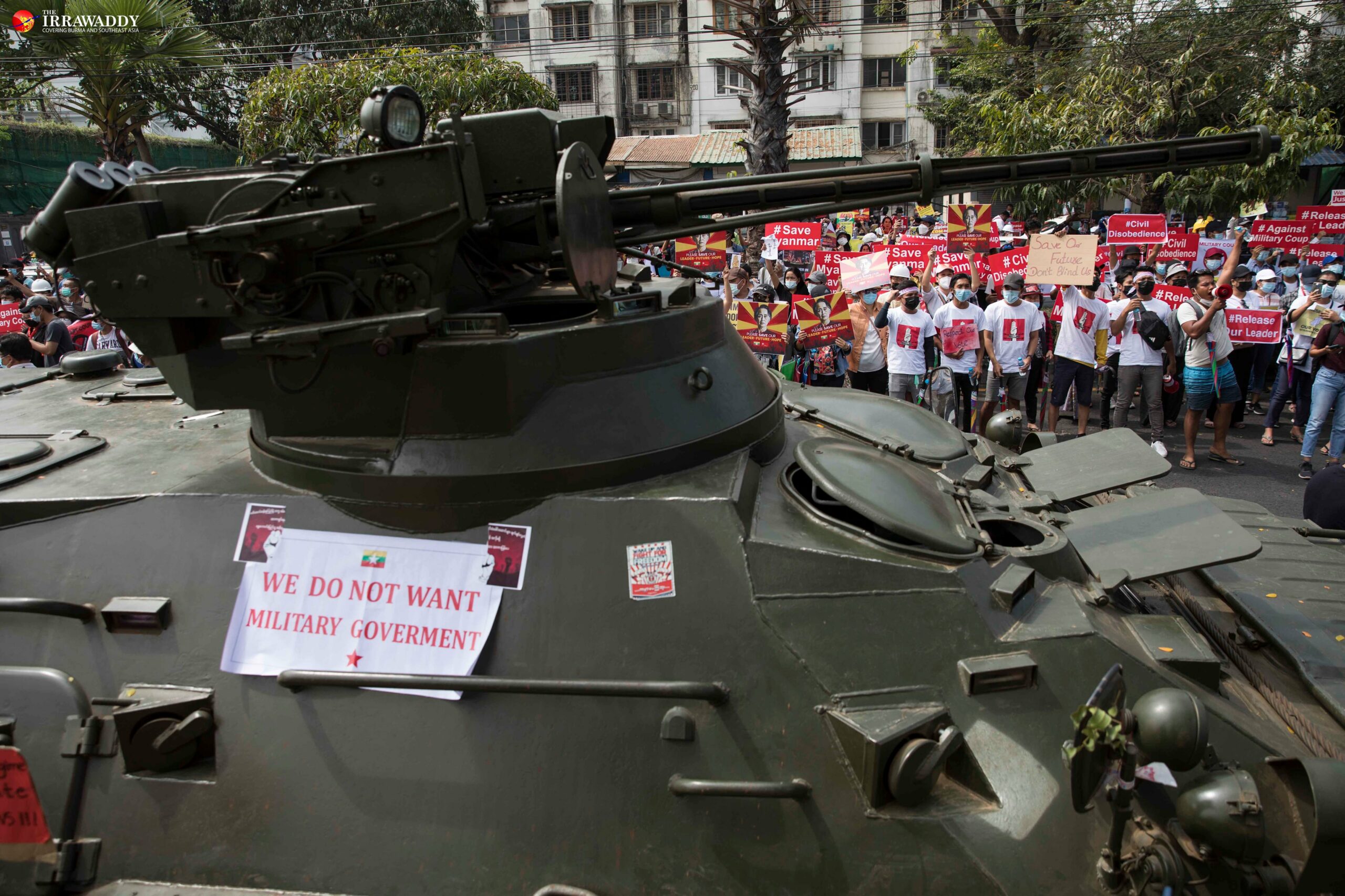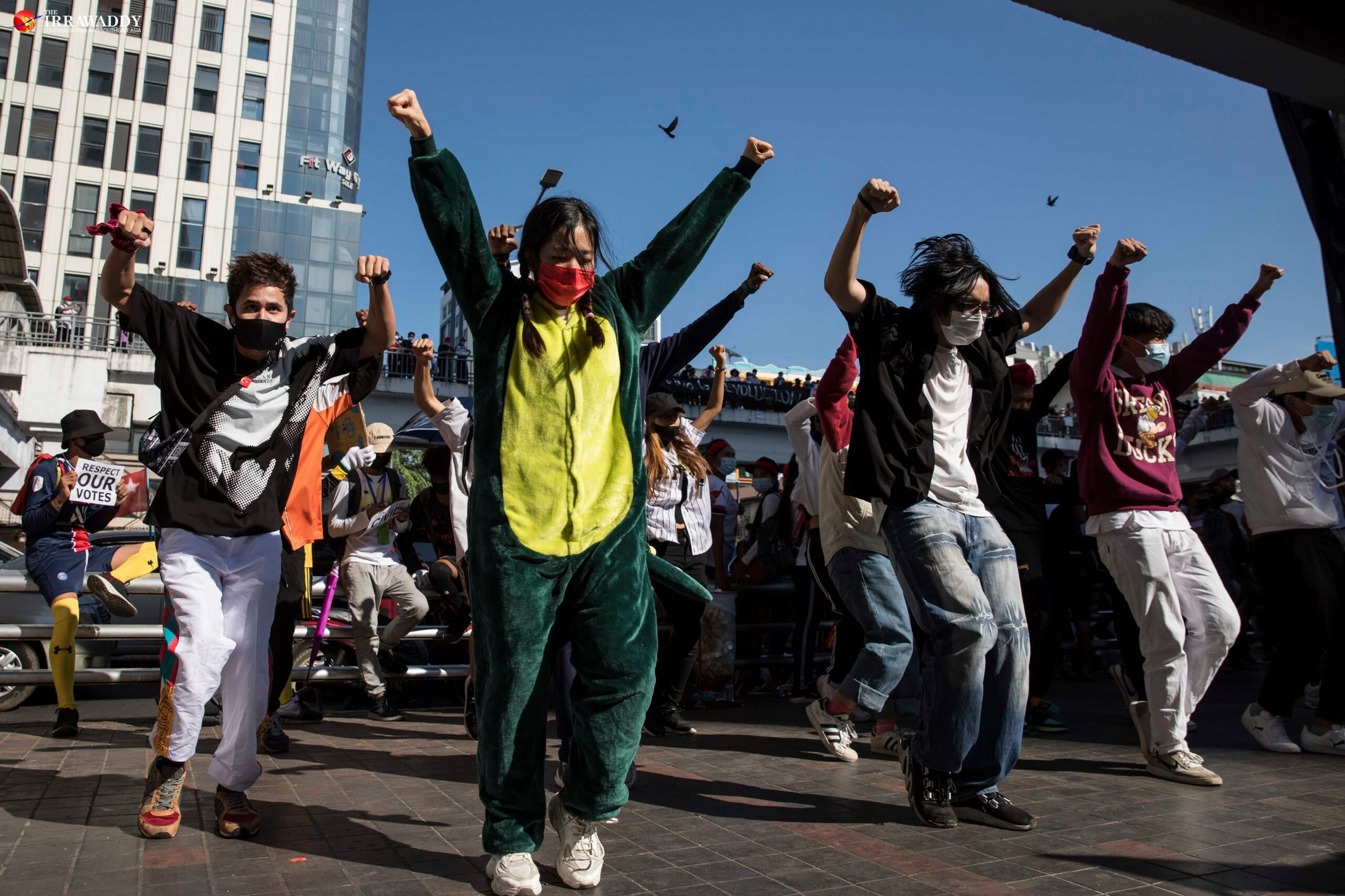Myanmar braced for a major crackdown on Sunday night as more troops were deployed to the cities and armored vehicles patrolled the streets of Yangon, Mandalay and Naypyitaw. When internet access shut down at around 1 a.m., reporters prepared their gear and cameras and prepared to face the inevitable. A friend sent a message: “Delete any sensitive information on your phone!” A colleague called me, whispering into the phone, “Lights are out.”
By 4 a.m., no news of a major crackdown had been reported, though there were some arrests, including five journalists and two local residents in Myitkyina, the capital of northern Kachin State. They were released on Monday. In the morning, the Civil Disobedience Movement poured back onto the streets of Yangon and Mandalay, as well as the national capital Naypyitaw—the “Abode of Kings”, once thought to be protest-proof but now filled with peaceful protesters and security forces.
For those of us who lived through past uprisings, it is hard not to see the fate of the nationwide Civil Disobedience Movement as preordained. We cannot help but replay the past in our minds, and relive the peaceful gatherings and uprisings that faced the military’s wrath and ended in slaughter.
We can see that the military is losing patience, but unleashing bloodshed in front of livestreaming smartphone cameras will be difficult. Since the coup two weeks ago we have seen several livestreams on social media in which citizens fought back against unlawful arrest and attacks by security forces. As in the past, if the military does launch a major assault it will be like digging their own graves.

However, it is frightening even to imagine how this latest confrontation will end. It feels like watching a train wreck in slow motion.
In November, just before the peaceful election in Myanmar, a colleague of mine sent me a message speculating on what the immediate future held for our country. The message predicted post-election violence and envisioned a scenario in which the military would intervene by staging a coup. At the time I dismissed his assessment—but deep inside, I knew there were ominous signs.
Later, after learning of the failure of last-ditch negotiations between the government and the military over the latter’s claims of electoral fraud, I knew we were traveling back into a dark tunnel. On Jan. 29, upon hearing that the two sides had been unable to reach a breakthrough, my colleague texted me simply: “Game Over”.
Indeed, much of the scenario laid out in the message in November—that within six months, the country would see violence, political polarization and the military’s eventual intervention—has come to pass, though the power grab came quicker than expected.

My colleague correctly predicted that the military would stage a coup, citing as justification its claim of voter fraud and an election that was neither free nor fair. Once in power, under this scenario, the military would announce that it intended to focus on key issues including ethnic conflicts, international pressure and economic stability. It also envisions that the military will amend the 2008 Constitution and hold elections, but without the NLD, resulting in a situation much like 2010, when the outlawed NLD refused to take part in the election. The message also speculated that former President U Thein Sein might be offered a seat in the interim government. That particular detail has not panned out—Senior General Min Aung Hlaing leads the SAC.
In retrospect, two high-level visits to Naypyitaw in the weeks before the coup by foreign dignitaries—one by the Russian defense minister (highly unusual) and the other by the Chinese foreign minister—now take on a whole new significance. If they didn’t have knowledge of the coup in advance, I would be very surprised. The military discussed the plan with some close allies at home and abroad. The generals have learned from neighboring countries, and from those further afield, and prepared thoroughly before staging the coup.
On Jan. 29, some senior military leaders in Naypyitaw reached out to ethnic armed forces and told them that, should any unprecedented incident take place in the country, the military wanted to continue working with them to achieve peace. In other words—a coup was on the way.
In 2018, at a café in downtown Yangon, I sat down with a high-ranking official who served in the U Thein Sein government. He warned me to keep in mind the events of 1958.

In that year, under General Ne Win, the military took power from Prime Minister U Nu’s government to restore order amid civil disturbances caused by factions among leaders of the Anti-Fascist People’s Freedom League. Under a “caretaker government”, Gen. Ne Win held an election in 1960. He handed power back to the winner, U Nu, only to stage a coup and seize it back two years later. Gen. Ne Win claimed to have saved Burma from the abyss and then ruled the country for the next 26 years. Our country became one of the poorest in the world as a result. Gen. Ne Win then endorsed his subordinates to seize power again in 1988 during the nationwide uprising. The “new generation” men in uniform ruled the country until 2010, when they held a sham election. The military-installed government opened up the country, and the West and the international community hailed the reforms and embraced the generals. I am afraid we will see a similar version of these events replayed in the near future. There are hostages in custody, and the military will say: “It’s time to negotiate. What is your price?”
The historical analogy has its limitations, however. Gen. Ne Win ruled in a very different era: He did not have to deal with the creative protest methods of Generation Z, nor were there smartphones, livestreaming, street performances and a horde of celebrities and affluent middle class protesters smiling and exuding a strange calm on the streets. Gen. Ne Win faced a different kind of protest and dealt with it in his own way, dynamiting the Student Union building at Rangoon University in July 1962 and killing many students. (None of which prevented him from receiving an invitation to the US, where he met President Lyndon B. Johnson in 1966.)
A week after this month’s coup, the Biden administration condemned the takeover and imposed targeted sanctions. The West and the UN joined the condemnation and backed the protest, the CDM and the ousted elected government. Within days of the coup, protests were mounted in front of the Chinese and Russian embassies in Yangon. To someone who experienced the 1988 uprising as a student protester, it was impressive; it would have taken us ages to mobilize such a movement and international reaction.

The military’s first mistake has been to underestimate the speed with which a mass movement would mobilize; it gave no consideration to the special strengths of Generation Z. Second, it thought the battle would be strictly between the military and NLD. But Myanmar’s youth emerged rapidly and have broken out from Daw Aung San Suu Kyi’s shadow to take charge of the resistance to the coup makers. These are everyday people—our neighbors. They say with calmness: “If we keep quiet now, gradually, we will become slaves to the military.”
The military has declared war against the people and the nation, and is trying to turn back the clock. To my colleagues who argue about whether this is a “soft coup” or the harder, cruder variety: There is no such distinction to be made; a coup is a coup. The one that took place in Myanmar two weeks ago has one aim: to take all of us back to the stone age.
You may also like these stories:
Journalists, Locals Detained Following Police Crackdown Released
Tycoons Close to Daw Aung San Suu Kyi Interrogated by Myanmar Military
Myanmar Court Extends Suu Kyi’s Detention, Delays Hearing for Two Days

















